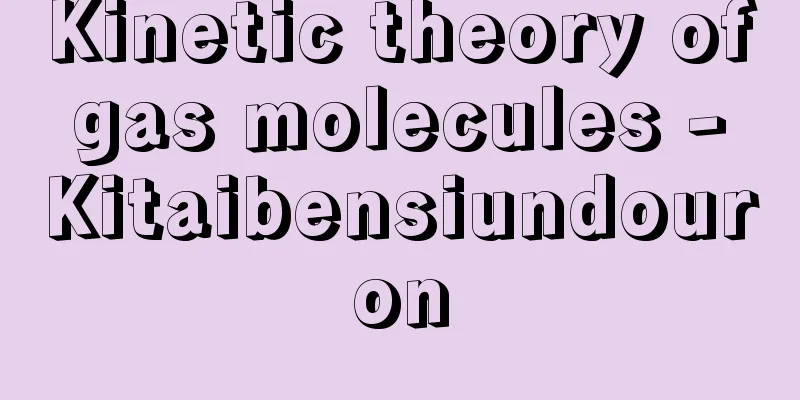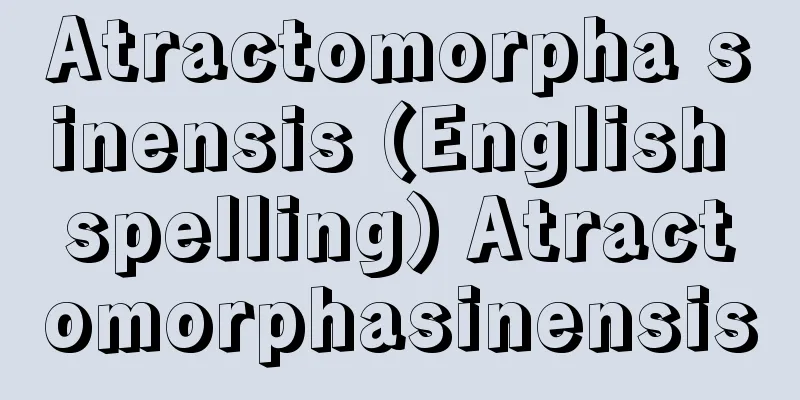Kinetic theory of gas molecules - Kitaibensiundouron

|
A theoretical system that starts from the discussion of the motion of gas molecules and derives the properties of gases. It was started by D. Bernoulli (1738), JP Joule (1851), and KA Krönig (1856), and was further developed by RJE Clausius (1857-1862), JC Maxwell (1859-1866), L. Boltzmann (1868-1876), and today it is an important branch of statistical mechanics. Unlike liquids and solids, the intermolecular distance in gases is large compared to the size of the molecules, so they can be most simply considered as a collection of hard spheres with no interaction. The pressure of a gas can be seen as the average value of the momentum change when these hard spheres collide with a wall, leading to the ideal gas law. In addition, by treating the motion of the molecules statistically, it is possible to calculate the velocity distribution function of gas molecules at any temperature (Maxwell's velocity distribution law). This law can be used to obtain thermodynamic quantities such as the average velocity, mean free path, number of collisions, and even specific heat capacity of gas molecules. Furthermore, because transfer of matter, momentum, and energy only occurs when molecules collide with each other along a certain mean free path, this theory also explains phenomena such as diffusion, viscosity, and heat conduction. However, experimental values for diffusion, viscosity, and heat conduction cannot be fully explained by a theory that ignores intermolecular interactions. D. Hilbert (1912), D. Enslog (1917), S. Chapman (1916-1917), and others reconsidered the theory so that intermolecular interactions could be taken into account. These theories have also been applied to the electron theory of metals and the phenomenon of discharge in gases, and they continue to develop. Source: Morikita Publishing "Chemical Dictionary (2nd Edition)" Information about the Chemical Dictionary 2nd Edition |
|
気体分子の運動を論じることから出発して,気体の性質を導いていく理論体系.D. Bernoulli(1738年),J.P. Joule(1851年),K.A. Krönig(1856年)によりはじめられ,R.J.E. Clausius(クラウジウス)(1857~1862年),J.C. Maxwell(1859~1866年),L. Boltzmann(1868~1876年)らによって発展され,今日では統計力学の重要な一部門になっている.気体では液体や固体とは違って,分子間距離が分子の大きさに比べて大きいので,もっとも簡単には相互作用のない剛体球の集りとみなすことができる.気体の圧力はこれらの剛体球が壁と衝突するときの運動量変化の平均値とみることができ,理想気体の法則が導かれる.また,分子の運動を統計的に扱うことによって,任意の温度における気体分子の速度分布関数(マクスウェルの速度分布則)を求めることができる.この法則を使って,気体分子の平均速度,平均自由行程,衝突数,さらには比熱容量などの熱力学的量も得られる.また,ある平均自由行程をもって分子相互の衝突が起こってはじめて物質,運動量およびエネルギーの移動があるので,拡散,粘性,熱伝導などの現象もこの理論から説明される.しかし,拡散,粘性,熱伝導などの実験値は,分子間相互作用を無視した理論では十分には説明できない.分子間相互作用も考慮できるように理論を検討しなおしたのは,D. Hilbert(1912年),D. Enslog(1917年),S. Chapman(1916~1917年)らである.これらの理論は,金属の電子論や気体中の放電現象についても応用され,なお発展を続けている. 出典 森北出版「化学辞典(第2版)」化学辞典 第2版について 情報 |
Recommend
Conrad, Johannes
[Born] 1839 [Died] 1915 A German economist of the ...
Brahmanism
...the religion and social ideology that is the p...
advertorial
...Since the late 1970s, in addition to governmen...
《Inference Chronicle》
...As the preface states, "If it records fac...
Man and Dog
…His representative works include Deforestation (...
Colmcille
…One of the three patron saints of Ireland. Irish...
phase transfer function
...In other words, the phase also changes. In thi...
Yakata - Yakata
1. A mansion where a person of high rank or social...
Constitution - Taishitsu
〘noun〙① The state or quality of something. ※Suika ...
Allende - Ajende (English spelling) Salvador Allende Gossens
Chilean politician. Born into a wealthy middle-cl...
Mechanical tapping - Kikai tap
…Increasing taps come in a set of three like hand...
Zokuden (English spelling)
Tribal land ownership such as yizhuang and saiden ...
SPUR
A magazine for young adults published by Shueisha ...
Crypto-xanthin
...The color of physalis, chili peppers, egg yolk...
Mitsutsuna Iga
1208-1221 A samurai of the Kamakura period. Born ...









